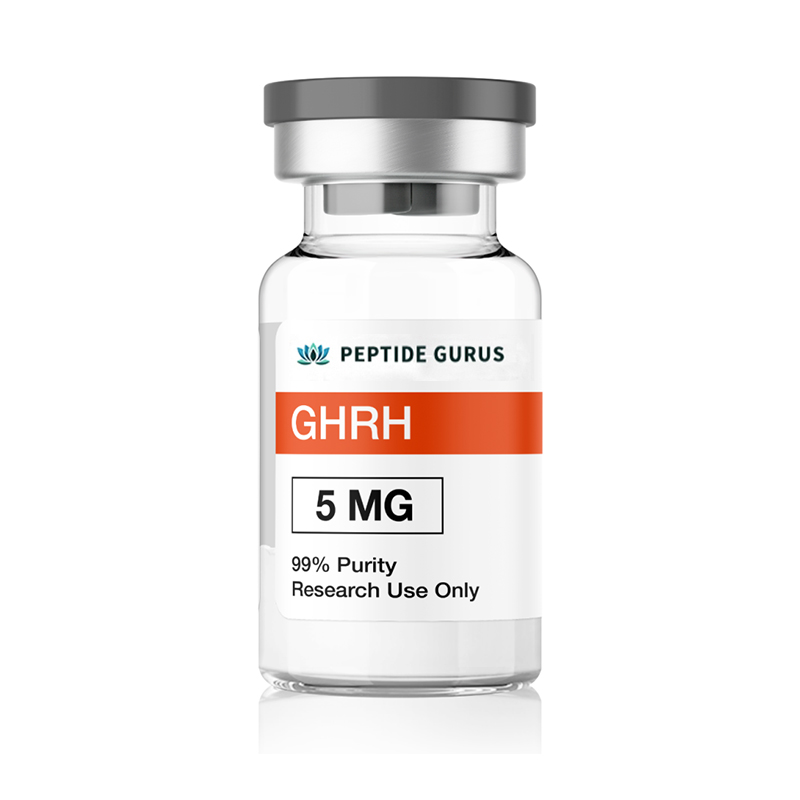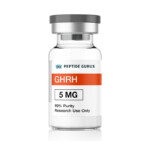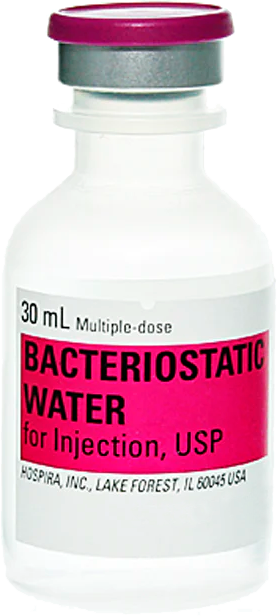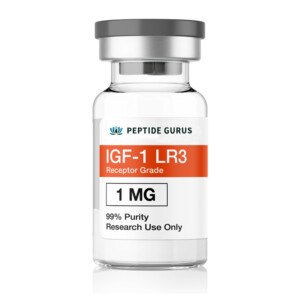Gratis (1) 30 ml de agua bacteriostática
con pedidos calificados sobre $500 Dólar estadounidense.
(excluye productos en cápsulas, péptidos cosméticos, códigos promocionales y envío)
Uso del producto: Este PRODUCTO ESTÁ DISEÑADO ÚNICAMENTE COMO QUÍMICO DE INVESTIGACIÓN. Esta designación permite el uso de productos químicos de investigación estrictamente para pruebas in vitro y experimentación de laboratorio únicamente.. Toda la información del producto disponible en este sitio web es solo para fines educativos.. La introducción corporal de cualquier tipo en personas o animales está estrictamente prohibida por la ley.. Este producto sólo debe ser manipulado por personal autorizado., profesionales cualificados. Este producto no es un medicamento., alimento, o cosmético y no puede estar mal etiquetado, mal utilizado o mal etiquetado como droga, comida o cosmética.
What Is Growth Hormone Releasing Hormone (GHRH)?
Growth hormone releasing hormone (GHRH) is a naturally occurring peptide released by nerves, called arcuate neurons, in the hypothalamus. The peptide travels from the hypothalamus to the pituitary gland where it binds to the growth hormone releasing hormone receptor and causes the release of growth hormone (GH). GHRH is critical for proper growth and development, increasing lean body mass and reducing adiposity (fat tissue). GHRH is indirectly responsible for muscle growth and long bone growth, but has also been found to regulate inflammation, mitigate pain, and play an important role in the sleep-wake (diurnal cycle). It is released in a pulsatile manner from the hypothalamus and thus causes the pulsatile release of GH as well. This pattern of release is important to the function of growth hormone and thus to physiology in general.
GHRH Structure
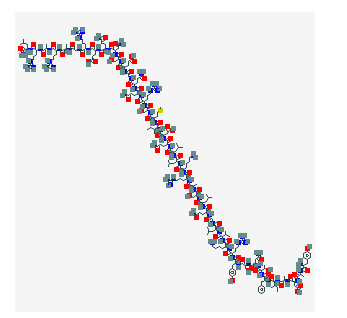
Secuencia: DL-Tyr-DL-Ala-DL-Asp-DL-Ala-DL-xiIle-DL-Phe-DL-xiThr-DL-Asn-DL-Ser-DL-Tyr-DL-Arg-DL-Lys-DL-Val-DL-Leu-Gly-DL-Gln-DL-Leu-DL-Ser-DL-Ala-DL-Arg-DL-Lys-DL-Leu-DL-Leu-DL-Gln-DL-Asp-DL-xiIle-DL-Met-DL-Ser-DL-Arg-DL-Gln-DL-Gln-Gly-DL-Glu-DL-Ser-DL-Asn-DL-Gln-DL-Glu-DL-Arg-Gly-DL-Ala-DL-Arg-DL-Ala-DL-Arg-DL-Leu
Fórmula molecular: C215h358norte72oh66S
Peso molecular: 5039.727 g/mol
PubChem CID: 44134750
Número CAS: 9034-39-3
Sinónimos: Factor liberador de hormona de crecimiento, somatocrinina, somatoliberina
GHRH Is an Unusual Hormone
GHRH, unlike other hormones, can exist in several forms. De hecho, its size can range from 37 a 44 aminoácidos, with the 44-amino-acid version be the most common and the standard reference when discussing GHRH. Curiosamente, these changes in size have no effect on overall function of the peptide as far as experimental evidence can discern and so the 37-amino-acid long version produces the same effects as its longer counterpart.
GHRH has a basal rate of release that varies with age and developmental status, but the pattern of pulsatile release remains regardless of the baseline level of the hormone. Research indicates that preserving the natural pulsation of GHRH, even during exogenous administration, is important to preserving normal physiology and preventing certain side effects.
GHRH differs from other hormones because, within the central nervous system, GHRH is found exclusively in the hypothalmus. While many hormones are widely distributed throughout the CNS, GH is not. GHRH is found, sin embargo, in peripheral tissues like the pancreas, corazón, thymus, and colon[1]. It has also been found, pathologically, in certain tumors.
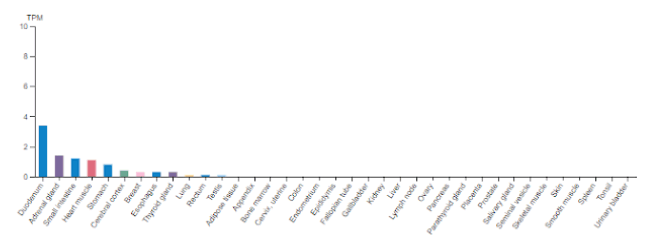
GHRH Analogs Are Common
A number of analogues of GHRH have been developed in an effort to target some of the peptide’s effects while avoiding other properties. Alterations have also been made in order to to prolong the half-life of exogenously administered GHRH. Examples of GHRH analogues include CJC-1295, sermorelina, and Tesamorelin. Tesamorelin was approved by the FDA in 2010 for the treatment of lipodystrophy (abnormal deposition of fat) in HIV.
GHRH Research
GHRH and Sleep
A significant portion of the total amount of GH released by the pituitary gland is released during non-REM sleep (NREMS). Curiosamente, GHRH administered exogenously promotes NREMS while suppression of normal GHRH release inhibits NREMS. Studies in mice suggest that GHRH is a critical factor in regulating the sleep cycle[2]. Curiosamente, the balance between GH and GHRH secretion may help to explain why mammals cycle between NREMS and REMS (REM sleep) throughout the night. Studies in mice show that an increase in GHRH leads to increased NREMS and GH release. The increase in GH then leads to an increase in REM sleep and a decrease in GHRH secretion. Este, por supuesto, boosts GHRH release and starts the cycle over again[3]. Defects in this axis may help to explain a number of different sleep disturbances as well as why changes in sleep patterns can lead to long-term health problems.
Obstructive sleep apnea (OSA) is well-known to cause a number of neuroendocrine dysfunctions and can lead to everything from heart disease to cognitive dysfunction. Patients with OSA have been found to have severe deficits in GH and GHRH levels, a factor that may explain why OSA leads to cognitive dysfunction as well as obesity[4]. There is some thought that supplementing GHRH in patients with OSA may help them to recover faster from the condition and reduce the occurrence of long-term side effects. Curiosamente, patients who have OSA and no cognitive deficits have normal GHRH levels[5]. This has lead scientists to investigate the role of GHRH in a number of neurological conditions (p.ej. enfermedad de alzheimer). Fortunately, CPAP therapy has been shown to improve the cognitive impairment and GHRH deficit associated with sleep apnea[6].
There is also evidence to suggest that the link between depression and sleep may be due to an imbalance between GHRH levels (to little) and levels of another hormone called corticotropin-releasing hormone (CRH). This imbalance has been shown to cause a decrease in short wave sleep while disinhibiting REM sleep[7]. These studies are in their most preliminary stages, but there is some hope that a deeper understanding of the GHRH-CRH balance may eventually lead to therapies that address not only sleep, but depression and its underlying mechanisms as well.
Traumatic brain injury (TBI) often affects the GHRH-GH axis and leads to substantial disturbances in sleep and mood[8]. En 2017, a phase 2 clinical trial studying the effects of GHRH analogue tesamorelin on sleep in individuals with TBI was undertaken. The study sought to determine if the peptide could produce changes in NREM sleep time compared to placebo. The results of the study have not yet been published, but the study underlines the keen interest in GHRH and its ability to regulate sleep.
GHRH and Obesity
GHRH, by stimulating GH release, is a potent muscle-building peptide and anti-obesity peptide. GH promotes the development of lean body mass, and supplementation with GHRH has been shown to do the same. Curiosamente, research indicates that obesity causes a decrease in circulating levels of GH by affecting GHRH secretion[9]. Scientists have long known that increased obesity makes it harder to lose weight and affects everything from appetite to the way the body absorbs calories (obesity actually makes the body more efficient at absorbing calories). Now it appears that at least part of this anomaly results from a decrease in GHRH secretion in obesity. En otras palabras, the more adipose tissue the body accumulates, the more GHRH secretion is reduced and the harder it is to lose weight. Scientists speculate that GHRH (or GHRH analogue) supplementation may be an effective means of jump starting weight loss until the cycle can be broken and endocrine regulation can be reestablished.
GHRH and Stress
It has long been known that GHRH secretion is suppressed in response to both physical and emotional stress. De hecho, careful studies have shown that stress, even psychological stress, can lead to delayed puberty, short stature, y depresión. These changes in development can be directly linked to changes in GHRH levels, but the exact mechanism by which stress affects GHRH has been unclear until recently. New research suggests that the change in GHRH secretion is a result of neuropeptide Y levels, which actually cause changes in the neurons responsible for GHRH production and release. It is thought that the change in GHRH release is designed to help preserve energy by restricting growth during times of famine. Desafortunadamente, this system is activated during any stressful event and prolonged stress, particularly during childhood, can lead to severe restriction of development[10]. There is some question as to whether GHRH supplementation might be indicated for individuals with severe physical and emotional distress so as to offset the negative effects on growth, development, inflamación, and cognition.
GHRH May Reduce Pain
Research in rats shows that GHRH is an effective way to relieve inflammatory pain. Curiosamente, the peptide reduces pain without affecting any of the inflammatory mediators that lead to it[11]. This may be clinically relevant as it offers doctors that ability to fine-tune an inflammatory response, reducing pain without impacting other aspects that may be important, such as the presence of nerve growth factor.
Of particular interest is the role of GHRH in reducing the pain associated with fibromyalgia. Fibromyalgia is a difficult to characterize condition associated with widespread pain, fatigue, and sleep disturbance. It has been known for some time, sin embargo, that exercise can have a significant and lasting impact on fibromyaglia pain. This fact led scientists to believe that GHRH or GH deficiency may play a role in the development of fibromyalgia. GHRH administration reduces pain in this condition and, as pointed out above, may help to reestablish normal sleep cycles[12]. Though there are currently treatments available for fibromyaglia, they are relatively limited in efficacy. The use of GHRH to treat the condition could represent a breakthrough.
GHRH and Prostate Enlargement
The exact reason that some men experience prostate enlargement (benign prostatic hyperplasia or BPH) has yet to be elucidated, but there is some evidence to suggest that chronic inflammation plays an important role in the process. Research in mice indicates that GHRH antagonism can reduce inflammatory cytokines in the prostate and actually lead to a reduction in the size of the gland. More importantly, GHRH antagonism appears to prevent hyperplasia in the first place, suggesting that GHRH antagonist therapy may be used to ameliorate BPH long before it becomes problematic[13].
GHRH Supplementation for Muscle Growth in Aging
Reduction in GH secretion and insulin-like growth factor-1 (IGF-1) are a part of aging but lead to decreased muscle mass and decreased strength in older people. Decreased strength leads to a number of problems such as gait abnormalities, bone density loss, changes in posture, and increased risk of falls and injury. Research in non-obese older men indicates that multiple daily injections of GHRH (or one of its analogues) significantly improves muscle strength and muscle bioenergetics without serious changes in blood lipid levels, peso, niveles de glucosa, or overall health[14].
Curiosamente, supplementing with GHRH also improves sleep in elderly patients and may lead to a decrease in cardiovascular mortality. The peptide also boosts cognitive function, likely by impacting sleep. Most individuals in these studies have also reported improved senses of well-being[15]. There is interest in extending these limited trials into long-term studies to determine just how far the benefits of GHRH extend in fighting the effects of aging and what, si alguno, side effects should be anticipated.
Acerca del autor
Investigación por L. Edmiston, MARYLAND. for
Recursos
- “Tissue expression of GHRH – Resumen – The Human Protein Atlas.” [En línea]. Disponible: https://www.proteinatlas.org/ENSG00000118702-GHRH/tissue. [Accedido: 05-junio-2019].
- F. Obal and J. METRO. Krueger, “GHRH and sleep,” Sleep Med. Rdo., volumen. 8, No. 5, páginas. 367–377, Oct. 2004.
- F. Obal, j. Alt, PAG. Taishi, j. Gardi, y j. METRO. Krueger, “Sleep in mice with nonfunctional growth hormone-releasing hormone receptors," Soy. j. fisiol. Regul. integral. Comp. Fisiol., volumen. 284, No. 1, páginas. R131-139, Ene. 2003.
- j. Xu, z. Qin, W.. li, incógnita. li, h. Shen, y W. Wang, “Effects of somatotropic axis on cognitive dysfunction of obstructive sleep apnea,” Sleep Breath. Schlaf Atm., Puede 2019.
- j. h. Xu, W.. Y. li, h. Y. Jin, Y. Ye, y W. Wang, “[Effect of serum growth hormone releasing hormone levels on cognitive function in patients with moderate-severe obstructive sleep apnea-hypopnea syndrome],” Zhonghua Jie He He Hu Xi Za Zhi Zhonghua Jiehe He Huxi Zazhi Chin. j. Tuberc. Respir. Dis., volumen. 41, No. 8, páginas. 606–610, Ago. 2018.
- l. Sun et al., “[Association between inflammation and cognitive function and effects of continuous positive airway pressure treatment in obstructive sleep apnea hypopnea syndrome],” Zhonghua Yi Xue Za Zhi, volumen. 94, No. 44, páginas. 3483–3487, Dic. 2014.
- “Impact of GHRH on Sleep Promotion and Endocrine Regulation in Service Members Who Sustained a Traumatic Brain Injury and Have Current Insomnia – Full Text View – ClinicalTrials.gov.” [En línea]. Disponible: https://clinicaltrials.gov/ct2/show/NCT02931474. [Accedido: 05-junio-2019].
- B. S. Kasturi and D. GRAMO. Stein, “Traumatic Brain Injury Causes Long-Term Reduction in Serum Growth Hormone and Persistent Astrocytosis in the Cortico-Hypothalamo-Pituitary Axis of Adult Male Rats," J.. Neurotrauma, volumen. 26, No. 8, páginas. 1315–1324, Ago. 2009.
- I. Ahmad, j. A. Finkelstein, t. R. Downs, y l. A. frohman, “Obesity-associated decrease in growth hormone-releasing hormone gene expression: a mechanism for reduced growth hormone mRNA levels in genetically obese Zucker rats,“Neuroendocrinología, volumen. 58, No. 3, páginas. 332–337, Sep. 1993.
- j. Deltondo et al., “Associations between the human growth hormone-releasing hormone- and neuropeptide-Y-immunoreactive systems in the human diencephalon: a possible morphological substrate of the impact of stress on growth,”Neurociencia, volumen. 153, No. 4, páginas. 1146–1152, Jun. 2008.
- R. S. Talhouk, norte. mi. Saadé, GRAMO. Mouneimne, C. A. Masaad, y B. Safieh-Garabedian, “Growth hormone releasing hormone reverses endotoxin-induced localized inflammatory hyperalgesia without reducing the upregulated cytokines, nerve growth factor and gelatinase activity,” Progreso. Neuropsicofarmacol. biol. Psiquiatría, volumen. 28, No. 4, páginas. 625–631, Jul. 2004.
- A. Leal-Cerro et al., “The growth hormone (GH)-releasing hormone-GH-insulin-like growth factor-1 axis in patients with fibromyalgia syndrome," J.. clin. endocrinol. Metab., volumen. 84, No. 9, páginas. 3378–3381, Sep. 1999.
- PAG. Popovics, A. V. Schally, l. Salgueiro, k. Kovacs, y f. GRAMO. Rick, “Antagonists of growth hormone-releasing hormone inhibit proliferation induced by inflammation in prostatic epithelial cells,”procesamiento. nacional. Acad. Ciencia., volumen. 114, No. 6, páginas. 1359–1364, Feb. 2017.
- j. Vittone et al., “Effects of single nightly injections of growth hormone-releasing hormone (GHRH 1-29) in healthy elderly men,” Metabolism., volumen. 46, No. 1, páginas. 89–96, Ene. 1997.
- A. R. Hoffman, S. A. Lieberman, y G. PAG. Ceda, “Growth hormone therapy in the elderly: implications for the aging brain,” Psychoneuroendocrinology, volumen. 17, No. 4, páginas. 327–333, Ago. 1992.
TODOS LOS ARTÍCULOS E INFORMACIÓN DE PRODUCTOS PROPORCIONADOS EN ESTE SITIO WEB SON SÓLO PARA FINES INFORMATIVOS Y EDUCATIVOS.
Los productos ofrecidos en este sitio web se proporcionan únicamente para estudios in vitro.. Estudios in vitro (latín: en cristal) se realizan fuera del cuerpo. Estos productos no son medicamentos ni fármacos y no han sido aprobados por la FDA para prevenir, tratar o curar cualquier condición médica, dolencia o enfermedad. La introducción corporal de cualquier tipo en personas o animales está estrictamente prohibida por la ley..


